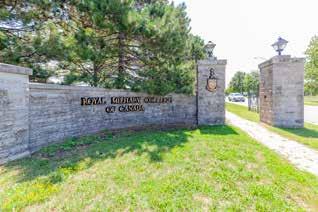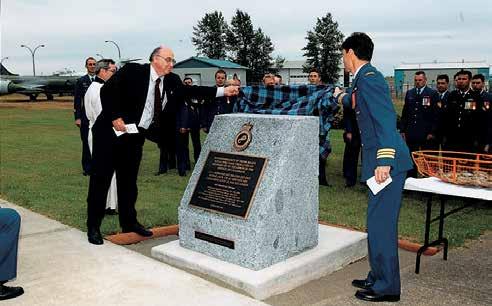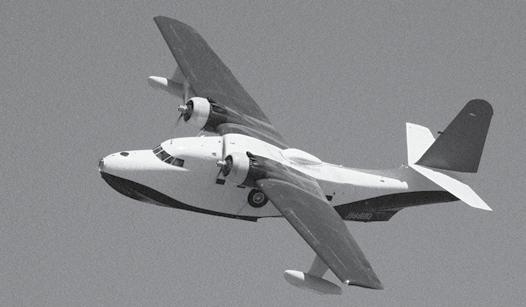
19 minute read
Walk Down the Mountain
Bob Reid
Walk Down
the Mountain
Originally published in The Scrivener in Fall, 2004
The Comox Valley Record of Wednesday, July 7, 2004, contained an article headed, “Cairn honors those who died in war, peace.” The photo caption read, “Former Navigator Bob Reid, sole survivor of a crash in 1966, uncovers the cairn.” The article described the unveiling of a cairn at the Comox Air Force Museum Heritage Airpark, honouring members of 442 Squadron who died during war and peacetime missions.
I was invited by the commanding officer of the squadron to attend this ceremony as a special guest and to speak to the current and past members of the squadron and the guests at the ceremony. The air crash was the event that most influenced and shaped my life. The following is part of my speech that day. “It is a great honour and privilege for me to speak to you today on this hallowed occasion when we remember and honour the men and women of 442 Squadron who gave their lives in the service of their country. I would like to express my deep appreciation to Lt. Col. Colin Goodman for inviting me to attend as a member of the squadron’s extended family. My close relationship with the squadron has meant much to me as over the years; the squadron and I have participated in memorial services at the site of the air accident in which my fellow crewmates were killed many years ago.
“In fact, it was 38 years ago—April 23, 1966, a Saturday morning— when I, as a young Flying Officer in the Royal Canadian Air Force, walked with my crewmates across the tarmac here at the base to board our aircraft, an Albatross flying boat, for our flight that day—a day that began like many other days, nothing out of the ordinary. The events of that day are etched so keenly in my mind, it seems like yesterday. “I can still smell the air that morning. It had rained the night before and the wind was fresh and brisk, skittering the clouds against a deep blue sky. Across the Straits the mountains were covered with snow. Little did we realize that a few hours later, our plane would crash on the Hope-Princeton Slide site and only I would survive. “It is important to us who are here today to remember and to honour those members of the Squadron who died on duty. I am here today to honour and remember my crewmates: (Flt. Lts.) Pete Semak and Phil Montgomery, (F/O) Chris Cormier, (LAC) Bob MacNaughton, and the passenger aboard that day, (S/L) James Braiden. Others are here to remember and honour loved ones, while others remember and honour ex-colleagues. And for those of you currently serving as active members in the squadron, it is especially important that you remember and honour these men and women because they are part
of the history and tradition of the squadron and of the Canadian Armed Forces in which you so proudly serve. “Recently we watched on television the ceremonies celebrating the 60th anniversary of the Canadian troops who landed at Juno Beach on D-Day. Canadians across Canada paid homage to those valiant soldiers who fought and died for our rights and freedoms. The men and women we honour today did not all die in battle against the enemy, but they did die serving Queen and Country. What greater sacrifice can a person make in the service of one’s country? Their deaths remind us of the ultimate price paid by those who serve and safeguard the people of Canada. “The dedication of this memorial cairn means a great deal to the friends and family members of the men and women of 442 Squadron whose sacrifice we commemorate today. They will live always in our memories and this memorial cairn will ensure they will be remembered as brave heroes of Canada long after we are gone.”
I have recounted orally many times the happenings of that day— Saturday, April 23, 1966. I do so again to leave a written account for my newly born granddaughter, Emma.
The story starts earlier in the spring of 1965 when a “sprog”1 navigator arrived at 121 Search and Rescue Squadron (121 was amalgamated into 442 Squadron in 1968) at RCAF Station Comox.
After graduation from the Royal Military College of Canada in June 1964, I received my wings in November 1964 as a long-range navigator at the Air Navigation School at RCAF Station Winnipeg. The next month, I froze and starved on bush survival training in Jasper National Park—not at the Lodge but
in the wilderness. Then in January 1965 came the final training at the Operational Training Unit (OTU) at RCAF Station Trenton. At the completion of training, the big question was: where would we be posted? Maritime Command or Transport Command? What base? The Air Force allowed each of us to submit three preferences for our future posting. I was the only one who got none of my preferences. I was given the posting everyone else wanted: RCAF Station Comox on Vancouver Island. Royal Military College of Canada (RMC) in Kingston, Ontario When I asked why I had not received any of my picks, the senior officer in charge told me that because I came from British Columbia, he had done me the favour of sending me home. I explained that my fiancée Robin (now my wife of 37 years) was in nurses’ training in Kingston, Ontario, which was why all my preference postings were in Ontario. The decision was cast in stone so, in March 1965, I loaded my 1964 Volkswagen Beetle with all my worldly possessions—mainly books—and took off across Canada for Comox.


I arrived at the airbase and within a few days was sent out on a search—thankfully with an experienced navigator aboard to show me the ropes. I settled in and flew on searches all over the province, usually searching for lost aircraft or overdue boats. The aircraft used for search and rescue missions was a twin-engine amphibian airplane called the Albatross, built by Grumman Aircraft Company.
The men (there were no women on squadron in those days) with whom I flew were highly skilled, brave, and dedicated in carrying out their duties. One difficult and traumatic example of their abilities was when our para-rescue personnel were dropped into the crash site of the Canadian Airlines flight on which a bomb had
Another was when a helicopter descended into the treetops on the west coast of the Island to lower medical personnel to ground level to allow them to treat badly injured survivors at a crash site. If the rotating blades had struck the trees, the rescue craft would have gone down. For this courageous and outstanding feat of flying, the pilot Dan Campbell was awarded the Air Force Cross. Other flights and searches took me to Kodiak Island in Alaska, to Whitehorse and Yellowknife, and all parts of the province. On CAVU days, the beauty of the land and sea was laid out before us to be admired and treasured. On miserable rainy and cloudy days, I’d occasionally talk a pilot into taking up the T-Bird (T-33 jet trainer) for SARAH (search and radar and homing) training runs. We would burst out of the clag2 into brilliant sunlight on top of an everreaching bed of white fluffy clouds with only the tips of the highest mountains peeking through in the distance. My favourite memories were the water landings and takeoffs, either in the waters of Georgia Strait or on one of the Interior lakes.
Grumman HU-16 Albatross



Helping affluent families protect and grow their financial wealth.

DIXONMITCHELL.COM
In 1965 I flew in the Abbotsford Air Show. To impress the crowds, we planned a JATO take-off. When we needed a boost to get airborne in a short distance, JATO (jet-assisted take-off) bottles were attached to the sides of the plane and fired as the plane started to lift off. A big flame would come flashing out and the plane felt as if some giant had kicked it in the rear. On take-off, however, a crosswind blew us over the dry, grassy infield so the flame set the grass on fire. Fire trucks and other emergency vehicles rushed to put it out. The crowd thought it was part of the display. It was impressive, though!
In April 1966, the squadron initiated a new crew system. The old practice had been for the pilots, navigators, radio officers, and crewmen to have their own duty lists, so we usually flew with different people. Now crew lists were created so we flew with the same people all the time. The crew on which I was the navigator comprised pilots Pete Semak, the captain, and Phil Montgomery, co-pilot; radio officer Chris Cormier, who had arrived at the squadron with me from the OTU; and Bob MacNaughton, an experienced crewman with whom I had flown on several searches.
At the end of April, my crew was scheduled to complete a weekend training flight. We planned to fly through the Hope-Princeton into the Skaha Lake region and spend the evening in Williams Lake. On the Sunday, we planned to travel into the Rocky Mountain trench area and return to base by Bute inlet.
We had taken on a passenger. Second Lieutenant James Braiden, a navigator from Trenton, arrived at the base for the annual checking out of the squadron’s nav leader Joe Scoles, who in turn would check out the rest of the squadron’s navigators. S/L Braiden was an old friend of the skipper; they had flown as a team in a “Canuck,” the CF-100, a fighter interceptor. Pete invited him to come with us on the flight.
The morning of the 23rd dawned on a beautiful day. It had rained the evening before and the air smelled of sea and ozone. The wind was brisk, scudding the clouds along the skyline with the Coast Mountains behind them across the water. We arrived for the weather briefing and filed our flight plan. Then prior to take-off, the aircraft was inspected inside and out and the instruments checked.
Once airborne we headed for Vancouver airspace. The radio crackled with the air-traffic noises from the tower and other aircraft. Navigation was simple because visibility was unlimited; the pilots could see far off into the distance. Vancouver was easily identifiable because of the brown smog that always hung over it.
After we passed Vancouver, we turned eastward up the Fraser Valley and when over Haney, my hometown, we circled. My family and friends knew if they saw a search and rescue craft circle, it meant I was aboard. Cloud cover started to build as we progressed up the Valley to Hope where we turned to follow the Hope-Princeton Highway into the pass between the mountains.
But the valley floor climbs rapidly in the pass. And the cloud cover was increasing.
At approximately 1130 hours, we were approaching the site of the Hope-Princeton slide where on January 9, 1965, a minor earthquake caused the mountain to come sweeping down, burying four people who had been trapped in their cars by an earlier mudslide. The mountain filled in the valley floor in the pass to a height 200 feet higher than before the slide and displaced Lake Outram.
As we were approaching the slide site, I was planning to get up and go forward into the cockpit to stand between the two pilots to get a better view of the slide. Usually when we were flying visually, I stood there but our passenger had preempted the position.
Instead I was sitting in the navigator’s seat, on the starboard side of the aircraft underneath the starboard wing, facing forward, with the radarscope in front of me. If I swivelled around, facing the rear, there was the nav desk on which the flight maps were laid out. On the starboard side of the aircraft were the radios and other instruments, all supposedly to assist me in determining the location of the aircraft with respect to the ground.
At this moment, however, the intercom squawked and I was asked how far ahead I could see on the radar. We were close to the ground; I could see only a short distance ahead on the scope. Travelling at 150 knots, that was not far at all.
The next and last call over the intercom was for “max power.”
The panic in the voice brought me immediately alert, then the throttles were thrust full and the plane banked to the left. Now I came wide-awake because I knew we could not turn the plane in the narrow pass. I looked out the window on the port side and saw the wing taking off treetops.
I instantly knew I was going to die. No one survives a plane crash onto a mountain. My life did not pass before me. Instead I experienced a crystal clear, cold realization that I was going to die. Then the plane banked again, this time to starboard and it started to slip into the mountain. The impact of the boat hull hitting the rocks caused loose gear to fly past me. A glimmer of hope sprung up? I thought the plane was going to land on the mountain. A rough landing for certain, but I had experienced rough water landings. It was a chance to survive.
Just then the plane dug deeper into the rocks and started to break up. The impact forced my face into the radarscope. My last conscious thought was of my nose and eyeglasses breaking. The aircraft was then torn apart on the mountain. There had been no possibility it could have landed intact. But at the time I was unaware of this. I had been knocked out.
When I came to, I was standing up, my left arm resting on a large boulder; I was enveloped in a white, misty fog with visibility limited to a few feet. I was alone. The aircraft and the others were not there. I was floating in space and I thought I was dead. For a long time after, I still could recall that eerie feeling.
I had no idea of how much time passed. My mind wondered what was to happen now that I was dead. My revelry ended when some part of the aircraft beyond my space blew up. A large hunk flew past my head and I realized I was alive.
A quick inspection revealed a flying suit in tatters, from my chest to my ankles; the exposed skin on my stomach and legs was red and raw. My hands were bleeding, as was my nose and mouth; all my front teeth had been knocked out. But there was no pain. There was an iceball in my stomach keeping the pain at bay. What I did not realize was that I had been severely burned—on over 50 percent of my body.
My immediate reaction was to call for help to find out whether other crewmembers had survived. No one answered. I thought they were either dead or badly injured; I had to get off the mountain and get help.
No one knew where we were. We would not be found until the cloud cover lifted and it could last for days. As it turned out, two people at the viewing site heard the crash but could not see anything because of the cloud cover. They heard my cries and went down the highway to get help. Four miles toward Hope, they encountered RCMP Cpl. Lorne Weme, who was on highway patrol.
In the meantime, I started walking down the mountain, trying to make headway among the rocks. At one stage my wristwatch fell off (the strap had been burned through); I remember thinking what a strange thing that was to happen and continued on my downward trek. (The watch presumably is still on the mountain.)
The rocks on the slide area became too difficult for me to climb around so I angled into the trees on the west side. Progress was better but fatigue was taking its toll and the iceball was growing bigger. I decided to lie down on a fallen log and rest. But at the back of my mind, something warned me that if I fell asleep, I would die. For the first time since I became conscious, I became frightened I would die. I had to get off the mountain. I had to get help!
I struggled downward until ahead of me, I could see the road. I stumbled out of the trees and shrubbery on the side of the road, just west of where the highway veered sharply south toward the other side of the valley floor around the slide site. A large car was passing as I stumbled out of the shrubs and trees on the side of the road. I waved vigorously, but it did not stop.
Discouraged, I sunk onto the sandy shoulder of the road and unfortunately got sand particles into the burn areas on my legs. Weeks later in hospital, a doctor cursed me as he picked out each grain with tweezers to prepare for
skin grafts. Meanwhile time passed and I waited on the shoulder—for how long and for what I don’t know—then a car came around the corner. It stopped and someone got out. Mark Gibbs was on his way to UBC when he came across a figure slumped and bleeding. Then Cpl. Weme appeared on the scene and off we went in his cruiser to the Fraser Canyon Hospital at Hope.
On the drive to Hope, I don’t remember much. I remember telling Cpl. Weme there were five other persons still on the mountain and that he must contact Search and Rescue to inform them what had happened. I also remember the wild ride down the highway with the siren screaming and the tires squealing as we took corners on two wheels. I yelled at him that I had been in one crash that morning and I did not want to be in another one. I also asked him to talk to me because I did not want to lose consciousness; the iceball was no longer working and I was getting colder.
The police cruiser had not even come to a full stop when I was out and stumbling into the hospital where help was waiting. Instinct told me that if I could get into the hospital, I would be all right. I never realized I was seriously injured.
I remember doctors and nurses hooking me up to various bags of fluids. Before losing consciousness, I asked the doctor if he would call my family but not to talk to my mother. He called and my mother answered the phone. He asked if anyone else was in the house and my brother Larry took the phone to receive the news of what had happened. My family drove up to the hospital where they were told I was badly injured and the doctors could not tell them I would survive.
I don’t remember being taken out of Fraser Canyon Hospital and put into a Search and Rescue helicopter, the same helicopter that retired this year at Comox from active service with the Armed Forces. I do remember landing, though. I did not know at the time that it was at Shaughnessy Hospital, a Department of Veterans’ Affairs hospital in those days. I remember being bundled up tightly and not being able to see anything: I was in a Search and Rescue stretcher.
I was placed on the ground and someone was hovering over me. I was asked, “Are you Protestant or Catholic, son?” The priest was prepared to give me the last rites. I answered, “Neither, Father.” The voice replied, “God bless you, my son,” and I could sense he moved away from me. I had officially changed my religious designation to agnostic at RMC. It was a feeble protest against the strict rules and regulations of the College and, at the time, I fancied myself a rebel—at least as much as anyone in military college could be. It did get me out of attending church, even though attendance at church parade was compulsory.
The sojourn in the hospital is another story that should be written—perhaps some day. For 6 weeks after the 23rd, I was in and out of consciousness. I survived and later that year, returned to Comox for a short visit. There I discussed with the squadron how I had survived the crash. Everyone thought I was in the tail section of the aircraft because only it and the left wing were intact. Everything else was in pieces.
One of the first people to reach the crash site was George Sowden, owner of the nearby Sumallo Lodge. He described what he saw. “There were bits of wreckage around a 1500 foot area” and “the mountain is covered with oil spots that have flashed and burned.” In fact, even today, if you look up the mountain, it glitters on a sunny day from the thousands of pieces of aircraft metal that remain scattered on the crash site.
In reconstructing what must have happened that day, the only logical explanation and the one I have recounted over the years is this one: When the aircraft slipped into the mountain prior to being ripped apart, the starboard wing dug in and was torn from the fuselage of the plane. This initial impact also knocked me unconscious and as I sat slumped in my seat, the port wing—full of aviation fuel—exploded. Its fireball blew me out the hole in the side of the aircraft created when the right wing was torn off.
The force of the fireball countered the forward momentum of the aircraft so I was not smashed to bits by the force of hitting the rocks on the mountain. Plus, I was breathing out when the fireball hit me so the heat did not sear my lungs. Those events had to occur in this exact order for me to survive the crash. Tragically my crewmates and our passenger did not survive. But every 5 years, a memorial ceremony at the viewing area near the crash site is held to honour their memory. s Bob Reid is Associate Professor Emeritus of Law.










